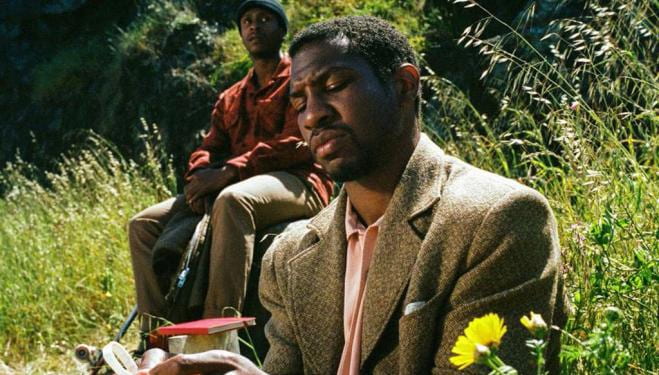Joe Talbot’s debut feature film The Last Black Man in San Francisco (2019) tells the story of a man who yearns for a sense of belonging and longs for a place to call his own. It is a love letter to San Francisco, with all of its beautiful architecture and the sprawling green hills of the Bay Area, shot by Adam Newport-Berra. However, Jimmie Fails’ odd personality and Jonathan Majors’ evocative acting capture the quiet violence that comes with being a Black person in an increasingly gentrified city. Through them, and the overarching themes of the film, Talbot portrays concepts from critical race theory. He does so both subtly and so conspicuously that they scream as one from the screen, begging to be acknowledged by the viewer. The Last Black Man in San Francisco tackles key themes of inferential, or modern, racism at its core and dabbles in the colonial underpinnings of gentrification and consequently, white privilege. Through the use of juxtaposition, irony, and depth of character, Talbot opposes these very themes by critiquing and dismantling them, creating an extremely anti-racist piece of media.
Critical race theory, as defined by its founders, is “a critical focus on the ways that race and ethnicity have been constructed in politics and popular culture and their consequences on everyday life.” In this paper, I will specifically be talking about how these concepts and their key points are depicted and challenged in film media. It may be helpful to first define some of the key ideas that come up in the following analysis.
Modern, or inferential racism refers to racialized assumptions and racialized languages and codes often assumed by the hegemonic class. This type of racism can include race-based judgments of one’s intelligence, viewing one as a “credit to their race,” and racist language, among other examples. Assumptions made based on race are often unspoken but reveal themselves in pre-existing systems of white privilege like unfair hiring practices, wherein a person with a “Black name” like “Tyrone” is proven to be less likely to get a job than a person with a more “White-sounding” name like “Sam.” Racialized languages and codes are often more audibly blatant, as is the case with former president Donald Trump, who has repeatedly used derogatory names for both people of color and women. Inferential racism ultimately perpetuates a system of racial inequity and general disrespect for people of color. In The Last Black in San Francisco, Talbot primarily uses inferential racism to juxtapose the city’s White residents with its Black.
White privilege stems from the United States’ deep-rooted history of colonization and slavery. It means that one racial group holds cultural superiority over the others. In a White-dominant society, White privilege gives White individuals countless advantages, each of which stems from White power structures, as outlined by Tim Wise in his documentary White Like Me.
Generational wealth and housing subsidies are just a few examples. White privilege discourse includes the idea that the United States was better off before the Civil Rights Movement; that the US is post-racial and racism is no longer an issue; that one Black individual represents every Black person; and that White people can be, and are actively being oppressed. Because Joe Talbot’s film is about gentrification, it directly correlates to White privilege structures of generational wealth and housing.
In his 2019 “How To Be an Anti-Racist” Ted Talk, Ibrahim X. Kendi defines antiracism as “a powerful collection of antiracist policies that lead to racial equity and are substantiated by antiracist ideas.” Antiracist ideas attempt to challenge every issue outlined in the critical race theory concepts previously mentioned. They “suggest that racial groups are equals in their apparent differences.” In the media, these depictions often look like portrayals of Black beauty, joy, and intelligence. Though these are human characteristics true to every demographic, Black characters in popular media rarely exhibit them. Antiracist media often confronts particular stereotypes of Black people by suggesting instead that people of color are no less human than the hegemonic group. Black characters are given depth and dimension. They have aspirations, wants, and needs. The point of antiracist media is equality, regardless of perceived differences. Every Black character in The Last Black Man in San Francisco is given dimension and depth.
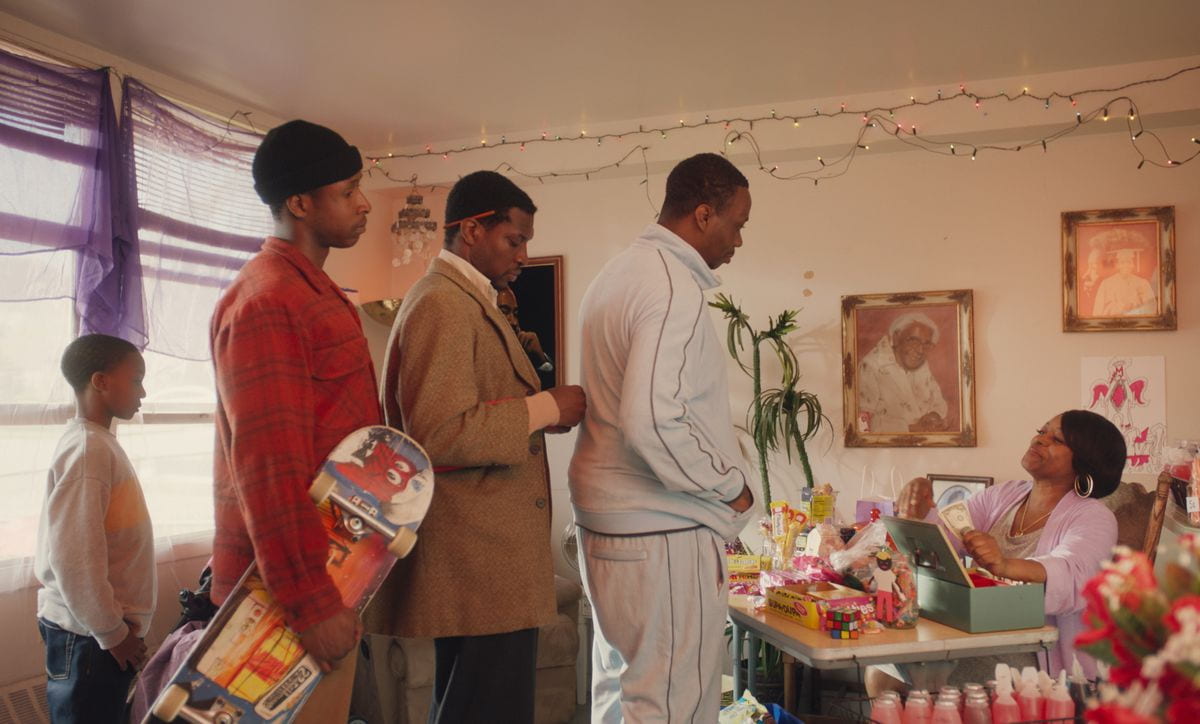
Jimmie Fails (himself) and Jonathan Majors (Montgomery) stand in line at the neighborhood candy store
One way antiracist media challenges racism is by making the audience aware of certain systemic, racial injustices. At its core, The Last Black Man in San Francisco is a story about gentrification. Black protagonist Jimmie Fails passionately tends to his childhood home, which his father inherited and eventually lost to what city officials at the time called “urban renewal.” It is a grand Victorian with turrets, multiple stories, and what Jimmie lovingly calls a “witch hat.” Jimmie believes that his grandfather built the house in 1946 after World War II. It is worth four million dollars, and said to be located in San Francisco’s historically Black Fillmore District, where many Black residents homes were seized and demolished for the purpose of “modernizing and improving aging infrastructure” in the mid 1970s (Pfau et al.). A White couple now owns it, but Jimmie stops by every day to touch up the paint and make sure the house is looking its best.
It may be helpful to examine this plot point through the lens of Tim Wise’s structure of White privilege and historical context. In White Like Me, Wise explains that post World War II, myriad opportunities arose for working-class Americans to buy their own homes and get things like job insurance. However, “between 1934 and 1962, 98% of FHA [Federal Housing Administration] loan recipients were white. People of color were almost completely barred.” The GI Bill, formerly known as the Servicemen’s Readjustment Act of 1944, provided large benefits to veterans. This included loans to start a business, cash payments for living expenses and school tuition, and perhaps most importantly – low-cost mortgages. However, “the vast majority of those who benefited from the GI Bill were white veterans,” due to legal restrictions in pre-civil rights America. The GI Bill of Rights was marketed as “an American way to make it easier for each man to take his place once again in a community, and get some of those things for which he went to war.” In short, it was a way to help working-class (White) citizens achieve a crucial part of the “American dream” – home ownership. Thus, it is one of the policies that built up America’s primarily White middle class.
In The Last Black Man in San Francisco, Jimmie’s pride is rooted in the belief that his grandfather truly did build the Fillmore house in 1946, post-war, and presumably, with a loan provided by the GI Bill. When a realtor puts the house up for sale, Jimmie tries to take out loans to buy it. However, multiple bankers tell him that his financial situation will make this impossible. Jimmie lacks generational wealth – an advantage that most White San Francisco homeowners possess. This disparity is due in part to the “urban renewal” that took place in the ’70s. After the city seized countless Black homes in the Fillmore district, many residents were given certificates promising public housing. However, these certificates were rarely honored (Arango). This forced displacement extinguished Jimmie’s family’s chance at generational wealth, and his father’s drug addiction likely made it all the more difficult to recover. Because Jimmie spent his childhood in and out of foster homes, one could assume that his lack of stability impacted his education and eventually his ability to get a white-collar or well-paying job. Consequently, White privilege continues to perpetuate the latter, since Black Americans still lack equal job opportunities.
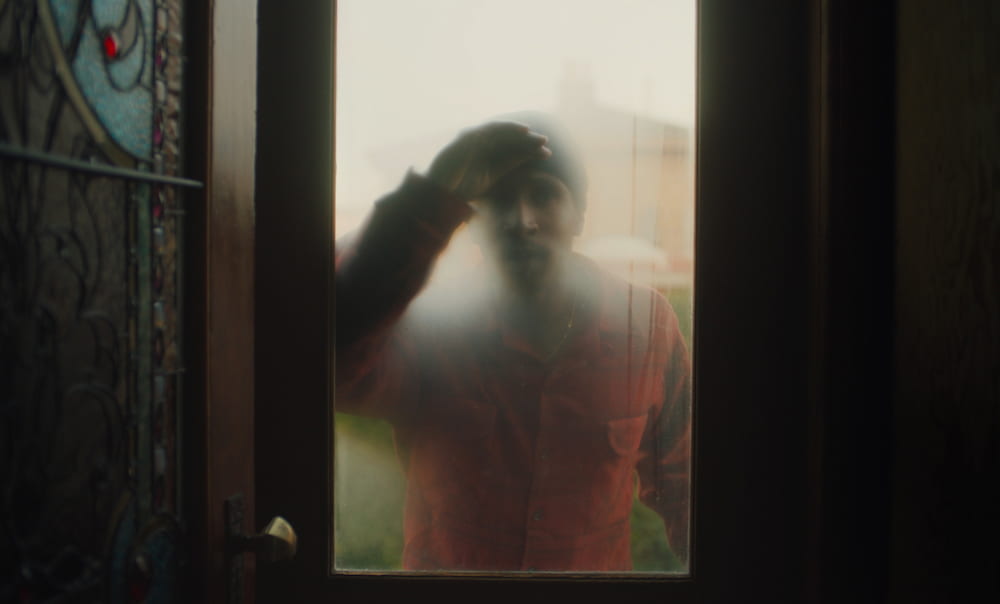
Jimmie Fails looks inside his childhood home
Towards the end of the film, Jimmie’s best friend Montgomery (played by Jonathan Majors) tells him that the house was actually built by Gill Cooley in 1857, almost one hundred years prior. There is proof of it in the lease, shown to Montgomery by the White realtor who is perceived as the villain of the story, though the ultimate villain is gentrification and the White people who play a role in it. A devastated Jimmie eventually moves out of the city that no longer has space for him. This depicts both White privilege and antiracism because the protagonist strongly yearns for what White privilege has denied him – ownership, pride, and land to call his own.
Talbot foreshadows Jimmie’s detachment from San Francisco at multiple points throughout the film, including uncomfortable juxtapositions that show how the city Jimmie grew up in has become unrecognizable. Toward the beginning of the film, as Montogomery soars through downtown San Francisco in slow motion on the back of Jimmie’s skateboard, White onlookers and tech bros gawk and stare, their expressions morphing from confusion to horror. Black civilians squat on the streets, selling drugs and wearing tattered clothing that depicts the drastic economic disparities between races. A White woman walks by wearing a mask. The races do not mingle. This depiction of inferential racism results in a sense of ironic alienation, as viewers watch the scene play out through Montgomery’s eyes. He and Jimmie are the ones being treated as intruders, though they are undeniably the characters who were born and raised in San Francisco. One can reasonably deduce that the White people look so horrified because they have assumed that Jimmie and Montgomery are drug abusers and dealers as well. They assume that they should feel unsafe and afraid. However, by painting this scene through Montgomery’s eyes, the film shows how absurd this assumption is.
In an earlier scene, a young Black girl skips down the street of Bayview-Hunters Point, an area that is a case study of environmental racism. It is also the neighborhood Jimmie currently lives in with Montgomery. She stops to ogle a White man dressed from head to toe in hazmat gear as he picks up trash. The scene is uncomfortable because a young child is living in a place with dangerous toxins in the air and water, while the White people are protected, engulfed in their hazmat bubbles of safety, which also seem to be a barrier against the Black community itself. This is a prime example of White privilege, as the people who moved into the city ultimately pushed the Black residents into unsafe areas.
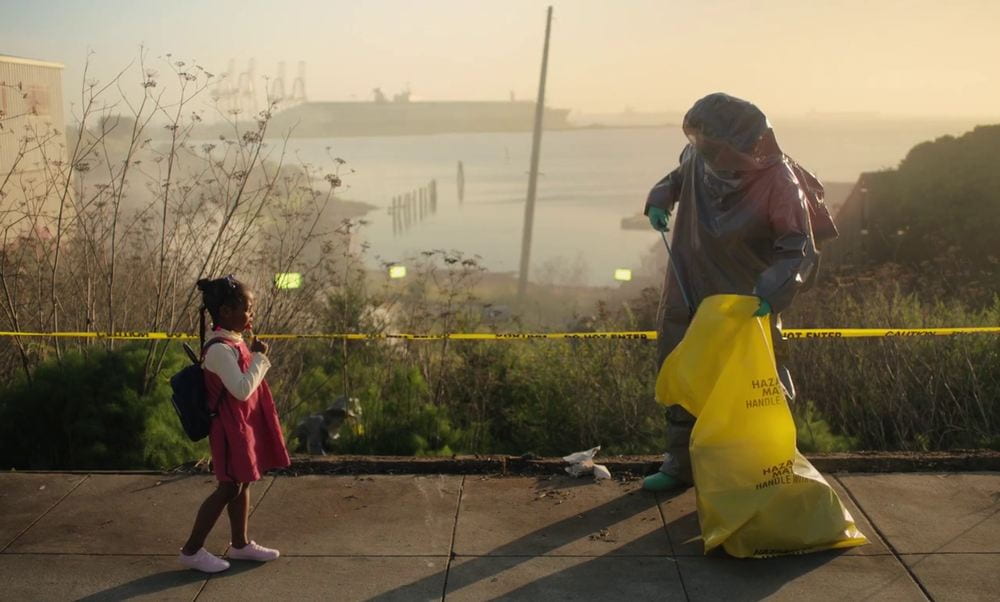
A man picks up trash in Bayview-Hunters Point
In the following scene, a Black man acting as an impromptu preacher, with a milk crate as his stage and oblivious Black onlookers as his audience, angrily declares the evident environmental inequities. “They here to clean this water?” he muses. “Man, this water been funky as the devil’s mouth for fifty years, and now they wanna clean it up? Not for you and me, no sir! They got plans for us.” he says, insinuating that once the toxins are all cleared up, they will be pushed out of their homes once again. These two scenes also depict Black joy and humanity – key aspects of antiracist discourse. One sees Black kids joyfully running around Bayview-Hunters Point, but Talbot juxtaposes this with the White people in hazmat suits, evoking an eerie representation of the kids’ innocence. The joy the kids possess is a simple freedom that does not come as easily to Black adults, as seconds later one hears the “preacher” preaching what social change must occur. In his character, there is an admirable dedication and passion. The audience catches a behind-the-scenes glimpse of him practicing his lines every morning before stepping onto his milk crate to recite them all day. Side by side, these two images – of the kids and the preacher – practically scream that the Black community is a valuable one, a human one, and one that should be protected. The preacher’s character is given a depth that shows how achingly human Black people are, and in turn, the importance of the social justice issues plaguing their communities. This directly opposes the White privilege concept of post-racial America, where racism is supposedly not an issue.
Talbot’s use of imaginative play depicts a Black joy relevant to antiracism because it is a passion one rarely sees acted out by Black characters, and yet it is always contradicted by the boundaries that restrict it. When the White couple inhabiting the Fillmore house lose it to a familial conflict, Jimmie and Montgomery decide to move in, despite their inability to officially own it. Montgomery is designated his own room, and they begin to view it as a genuine, permanent home. The two pound through the house, taking it in in wonder. Montgomery happily flings handfuls of leaves off the roof. When a tour guide proclaims the house was built in the 1850s, Jimmie proudly corrects the tour group with its mythical origin. In one scene, the best friends start screaming at the top of their lungs, reveling in the freedom they now possess. “The neighbors?” asks Montgomery. They shrug and both continue to yell. The two of them feel so free, they cannot be bothered to think about anyone else. By showing Black joy and Black people free to dream, Talbot challenges typical Black stereotypes, wherein individuals are one-dimensional.
In another scene, we catch a glimpse of what Jimmie yearns for. He lies on the couch in the morning and says he plans on “scratching his ass” and reading the newspaper. When Montgomery says that Jimmie does not even read the newspaper, Jimmie says, “Because I never had a home to read it in.” The conversation is lighthearted, but this sentence has a weight to it, as it represents a simple pleasure Jimmie has never had and has always wanted, after his father lost the home, landing Jimmie in various foster homes. Each example of Black joy mentioned above is torn from Jimmie and Montgomery when they come back to the house one day to find that the white realtor has had all of their belongings put out on the street.
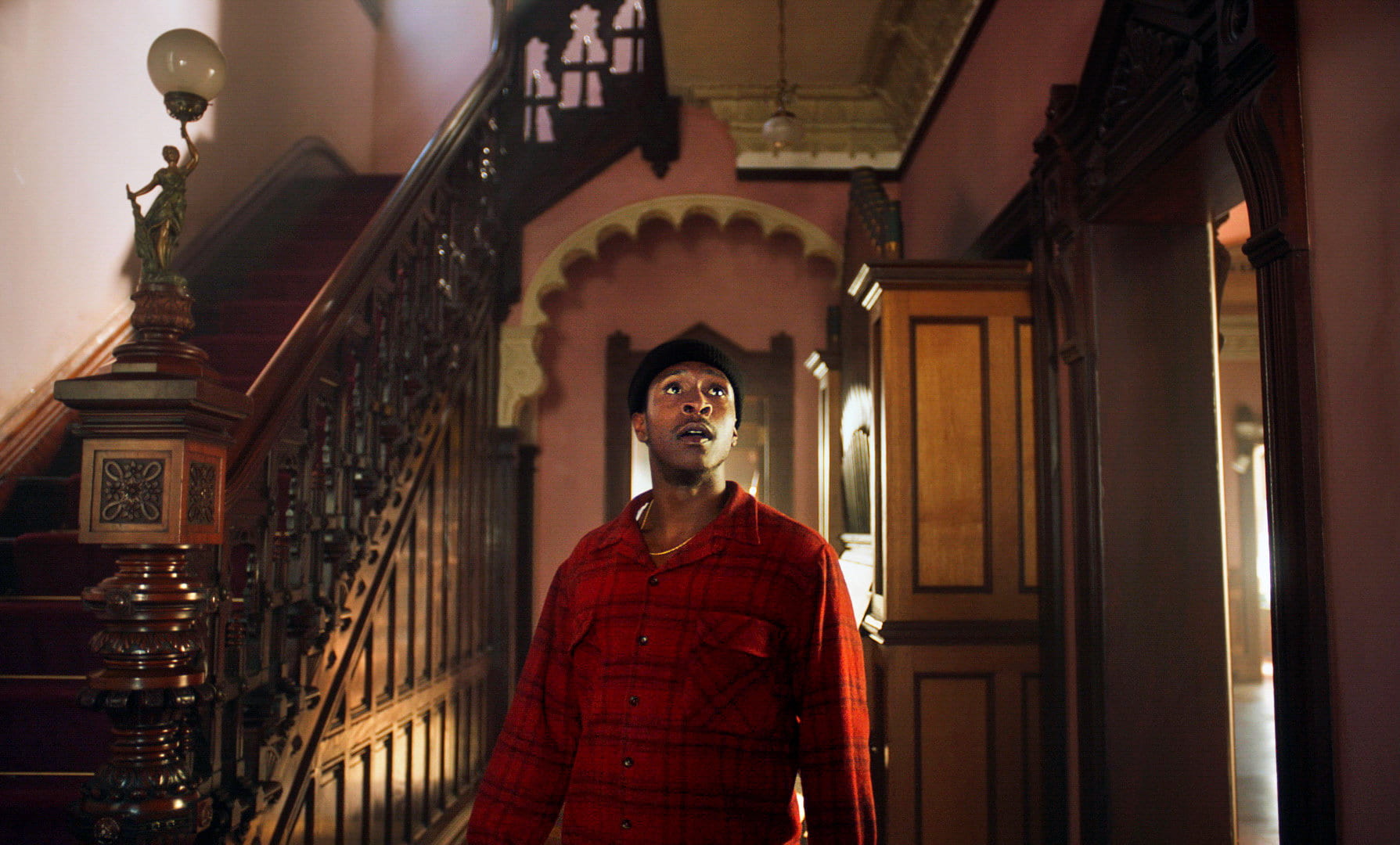
Jimmie reunited with his childhood home
This concept of a Black person wanting a reality so badly they get lost in it is the opposite of victimization because it provides the person room to dream. However, the reality of the situation reminds the viewer of why and how the United States has made this extremely difficult for the non-hegemonic class. A racist portrayal would have simply depicted Jimmie as a poor Black person who cannot afford a house. This is not necessarily untrue, but it is in the lack of nuance and over-simplification of the Black character that inferential racism perpetuates through the media. In describing post-war America, critic Robert Daniels writes in his article “The Fairytale of Ownership in The Last Black Man in San Francisco” that Black people have constantly been relegated to a second-class existence. In believing his grandfather’s myth, Jimmie “eventually realizes he’s relegated himself to the same fate, dutifully buying into the fantasy offered by America and his grandfather” (Daniels, 2019).
Gender and Blackness go hand in hand in this film. It may be helpful to split the ideas of Black manhood into two character groups. First, the symbolic “Greek Chorus,” a group of young Black men who ultimately represent the not-so-pleasant, yet painstakingly genuine aspects of the Black community. Second, the loving friendship Montgomery and Jimmie share.
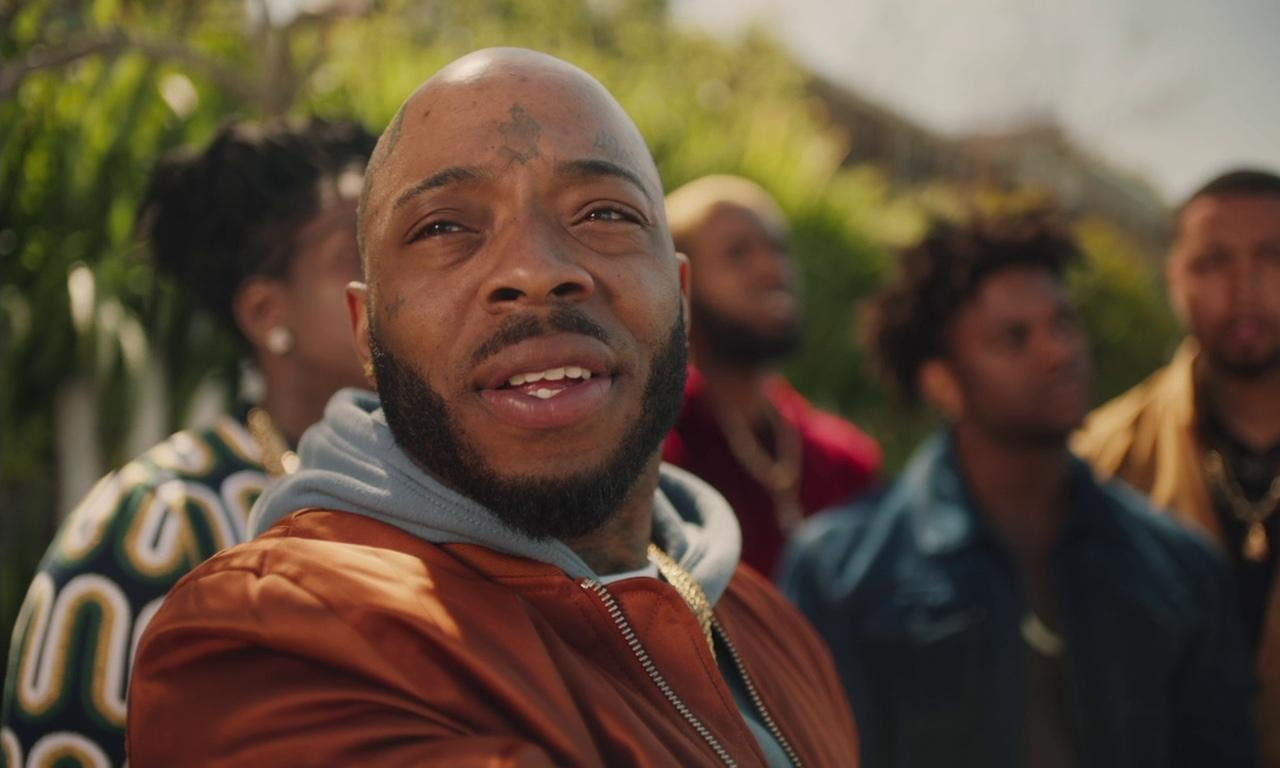
Antoine Redus (Nitty) and the rest of the Greek chorus
Throughout the film, the “chorus” repeatedly represents aspects of hegemonic masculinity. At first glance, they all appear to embody the characteristics of the stereotypical Black man – toxic masculinity, crime, and gang violence. Over and over, they are mean to Jimmie and Montgomery, making fun of their clothes and Montgomery’s “feminine” characteristics. His quiet manner is viewed as timid and his interest in the arts (playwrighting) is also considered “unmanly.” The Greek chorus is also mean to one another, pushing each other to perform hegemonic masculinity. Because Montgomery is writing a play based on them, the audience often watches them interact with each other from Montgomery’s perspective, where it becomes clear that each member of the group is acting what they believe masculinity should be. In one scene, the group urges Kofi, a character who later dies from gang-related violence, to hit one of them. He cannot bring himself to do it and his friends taunt him. Later on Nitty, one of the friends who ridiculed him, collapses, crying about Kofi’s death on Jimmie’s shoulder. The audience sees the chorus grapple with the hegemonic masculinity they believe they should embody, while simultaneously showing genuine emotion. These dimensional portrayals critique hegemonic masculinity as well as defy stereotypes of Black men, who, through an inferentially racist lens, are violent, emotionless, and criminal.
As previously touched on, Montgomery’s character defies hegemonic ideas of masculinity by appearing timid and artistic. Harris O’Malley of “The Good Man Project” describes how such traits are viewed through the hegemonic lens. “Supposedly ‘feminine’ traits––which can range from emotional vulnerability to simply not being hypersexual––are the means by which your status as a “man” can be taken away.” Montgomery could be perceived as an example of the “failed” masculinity archetype, however, he challenges this idea; his character is not in the film purely for laughs. The only people who laugh at him are the Greek chorus, but the chorus’s actions are those meant to be appraised. When Montgomery later looks into a mirror and attempts to copy the chorus’s words and demeanor, he is trying to embody the hegemonic masculinity he sees them perform. However, he is not able to hold it up for long. Still, the audience respects him because his odd, eccentric personality has been portrayed as genuine, endearing, and kind. In these nuances, Talbot pushes the audience to question what Black masculinity truly is, prompting antiracist reflection.
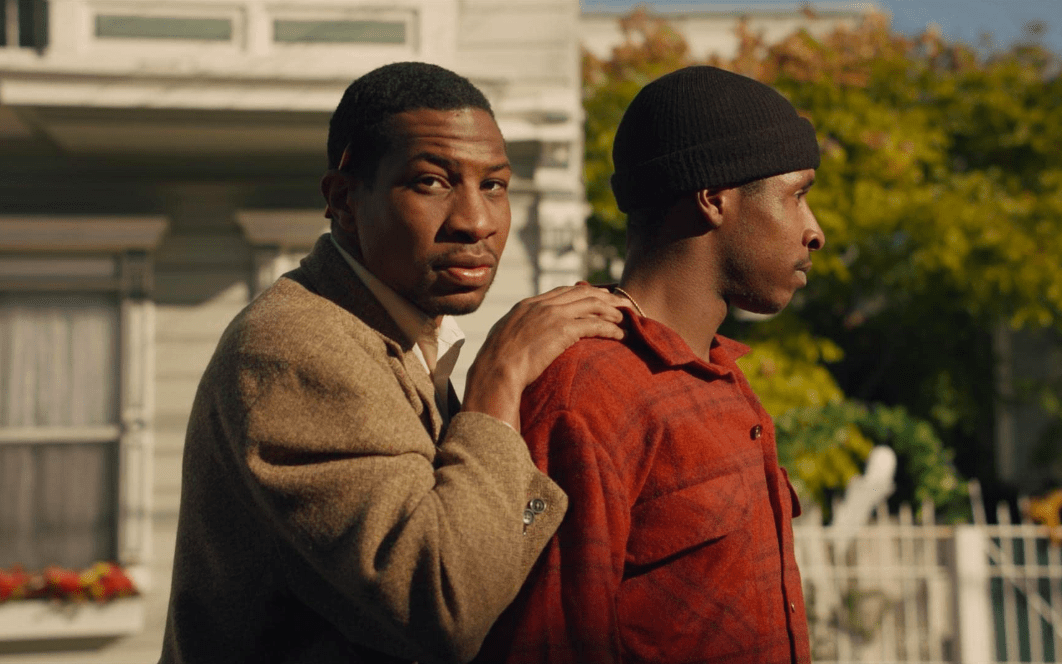
Montgomery rides through San Francisco on the back of Jimmie’s skateboard
When Montgomery is himself, one sees a portrayal of Black love that is rarely as pure as his friendship with Jimmie. They have undying respect for one another, as Montgomery lets Jimmie live with him while also helping him touch up the Fillmore house. He cares for what Jimmie cares for, and is brutally honest when he needs to be. Together, they are charming and undeniably weird, thus the audience comes to love and respect them. By showing this friendship, Talbot challenges both gendered and racial stereotypes. The men exude such love and care, the Greek chorus calls them queer. This problematic statement speaks to the chorus’s restrictive view of masculinity and its homophobic underpinnings, while simultaneously bringing attention to how much more emotion is represented in Jimmie and Montgomery’s friendship than in typical representations of platonic, Black male friendship.
Jimmie Fails left San Francisco because it no longer resembled his home. It failed to provide him opportunity, and rapid gentrification restricted the Black community from maintaining its rich culture. It no longer uplifted Black voices, nor did it allow Black people to be complex, dynamic, and to extend past a property value. Conversely, Talbot’s film offers the audience enough glimpses of true Black community to understand the urgency of gentrification.
Film can be used as a powerful tool in dismantling and opposing inequitable ideas. Through social justice themes, irony, racial juxtaposition, historical context and depth of the Black character, Joe Talbot uses the The Last Black in San Francisco to demonstrate the effects of systemic racism on communities and individuals. By depicting racist concepts outlined in critical race theory, and either shedding light on their absurdity or proving them untrue, he promotes antiracism. Blackness is portrayed as beautiful, complex, and raw. Black men are permitted to show emotion and struggle with the restrictive form of masculinity that the hegemonic society, and often their own culture, expects them to take on. Antiracist media defies racism by creating equality in representation. Just as popular film has historically shown a wide range of White characters with dimension, Talbot creates a world in which every Black character is human.
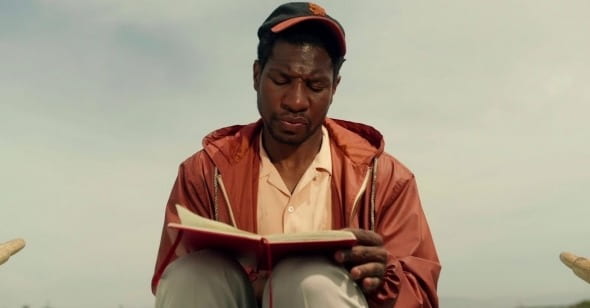
Jonathan Majors (Montgomery) sits in a rowboat in Bayview-Hunters Point while working on his play
This essay was produced in USF’s Media Theory & Criticism spring 2023.
References
Arango, T. (2023a, May 16). Can reparations bring black residents back to San Francisco?. The New York Times.
A24. (2019). The Last Black Man in San Francisco [Film]. United States.
Daniels, R. (2019, July 10). The fairy tale of homeownership in the last black man in San Francisco: Features: Roger Ebert. Features | Roger Ebert.
Ibrahim X. Kendi. (2020). How To Be an Anti-Racist. TED panel Interview.
Wise, Tim. (Director) (2013). White Like Me: Race, Racism and White Privilege in America.(Documentary). Media Education Foundation. Retrieved through Kanopy, USF.
O’Malley, H. (2019, June 22). The difference between toxic masculinity and being a man. The Good Men Project.
Pfau, A., Hochfelder, D., & Sewell, S. (2021, September 30). Urban renewal. The Inclusive Historian’s Handbook.
Simmie, E. & Lawhorn, B. (Hosts). (2022, April 28). The Last Black Man in San Francisco. (No. 33). [Audio podcast episode]. 24 Minutes of A24. Spotify.
ABOUT THE AUTHOR:
 Mila Danilov is a third-year Media Studies and English in Writing student at the University of San Francisco. She is originally from Seattle, Washington and enjoys creative writing and all things film.
Mila Danilov is a third-year Media Studies and English in Writing student at the University of San Francisco. She is originally from Seattle, Washington and enjoys creative writing and all things film.
